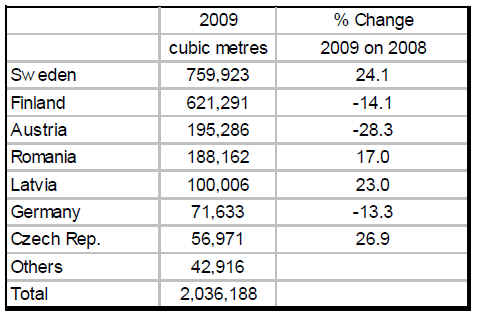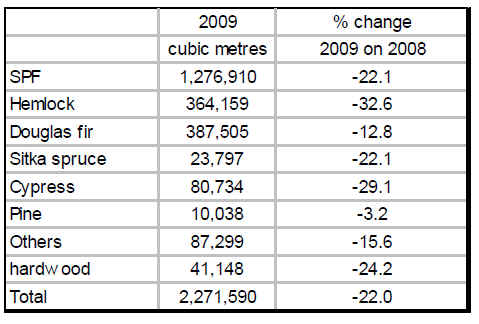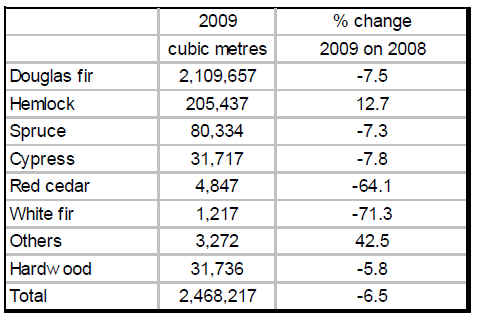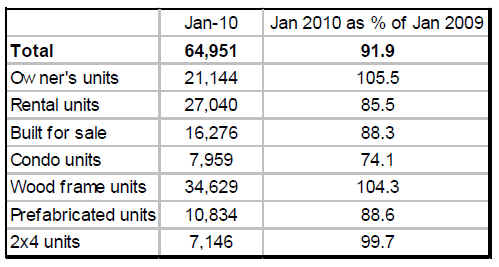Japan Wood Products
Prices
Dollar Exchange Rates of
13th March 2010
Japan Yen 89.10
Reports From Japan
Chile quake hits industry
The devastating earthquake that struck Chile at the end of
February has seriously affected the timber industry. The
city of Concepcion, which was close to the earthquake
epicentre, is the hub of the log and lumber industry in
Chile and has suffered major damage.
The Japan Lumber Report (JLR) reports that, while the
main port suffered little damage, power supplies have been
cut and road access to the port is almost impossible. The
indications are that all shipments scheduled for March
have been cancelled and this will affect importers in Japan
and Korea, amongst others.
Reports on the damage suffered by sawmills are still being
received and from first indications it would seem that
some mills close to the ocean have been destroyed. Other
mills are reported to have suffered some damage but have
been able to continue production at a reduced rate. As
access to the ports is affected, stocks are piling up at most
mills, says the JLR.
Wood promotion in public buildings
Details of the content of the Bill on promoting wood use in
public buildings are reported in the JLR. The Ministry of
Agriculture, Forestry and Fisheries, Japan has drafted the
Bill, aimed at raising the use of wood in low rise public
buildings from the present level of 7.5% to 20-30%. This,
according to the Forestry Agency, could increase wood
consumption by between 700-800 thousand cubic metres
annually.
The package of support for manufacturers comprises legal,
financial and technical elements which are still under
discussion. The JLR reports that this initiative in the
public sector will have a knock-on effect on the private
sector leading to a greater use of wood in buildings.
European softwood lumber imports
Total imports of European softwood lumber by Japan in
2009 were 2,036,188 cubic metres, some 1.3% more than
in 2008 according to the JLR. Finland and Austria lost
market share while Sweden became the top supplier due to
favourable exchange rates relative to the Euro.

N. American lumber imports
In 2009, Japan imported 2,271,590 cubic metres of N.
American lumber, the lowest since 1975 and 22% down
on imports in 2008 says the JLR.

N. American log imports
Total 2009 imports of N. American logs by Japan are been
reported at 2,468,217 cubic metres by the Japan Lumber
Importers Association; this represents a decline of 6.5% on
2008 imports. The most popular timber was Douglas fir
which accounted for some 80% of 2009 imports, says the
JLR.

Firming log prices
The JLR is reporting that log stocks, built up when log
prices were lower than at present, have almost been sold.
Currently, higher priced logs are coming into the domestic
market and wholesale log prices are moving up. In
addition, higher FOB prices and the slightly weaker Yen
should add momentum to this upward trend in prices.
In early March Sarawak Meranti prices were up around
Yen 300 per Koku to Yen 6,200 while Meranti small logs
were at Yen 5,200 per koku. Sabah Kapur log prices
remain unchanged at Yen 8,900 per Koku.
Tropical log peeler mills in Japan are maintaining their
reduced production levels. With signs of firming prices for
imported plywood, these mills will soon have an
opportunity to raise prices and this will lead them to
increase log purchases.
According to the JLR, FOB prices have been increasing
slowly but steadily in the face of a somewhat limited
supply because of the rain season in Sarawak. The rain
season will soon end but it will take time for log stocks to
build again.
Current export prices are at US$190 per cubic metre for
Meranti regular and US$155 per cubic metre for Meranti
small. Kapur prices are reported at almost US$260 per
cubic metre in Sarawak and Sabah.
January housing starts
Housing starts in Japan have final stopped declining says
the JLR. Since November 2009, housing permits have
been increasing, indicating that construction activity
should start to pick up. In January 2010 starts were 8%
down on January 2009 which maked 14 months of
unbroken decline.


|